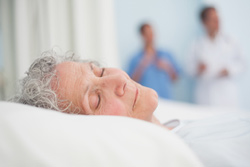Bedsore and Pressure Ulcers in California Nursing Homes
By Dr. Natasha Das
 If you have a loved one experiencing unexplained bedsores (pressure ulcers) then it may be a sign of elder neglect or abuse.
If you have a loved one experiencing unexplained bedsores (pressure ulcers) then it may be a sign of elder neglect or abuse.
Often times, seniors are left neglected in California nursing homes and you may have a case.
Contact our nursing home abuse lawyer for a free case review. We'll discuss your options free of any charge. Call 949-203-3814.
Are you aware that staying in bed in unchanged positions for long durations can cause bedsores, which can at times, turn fatal?
Are you aware that there were 474,692 new cases of bedsores in the US due to patient safety incidents in 2000-2002? (1 )
Are you aware that 13.13% of bedsores resulted in the death of patients in the US in 2000-2002? (1 )
Unfortunately, bedsores are a serious concern for residents in long-term care facilities such as nursing homes. They are one of the most common signs of nursing home abuse. About half of California's nursing homes lack the standards set by Federal law to prevent bedsores in nursing home residents. What is a bedsore? How can it turn fatal? Read on to find out more...
What is a bedsore?
A bedsore is a sore or wound that may occur due to prolonged stay (mostly, in bed) in one position for too long. It is also called a 'pressure sore' as it occurs due to constant pressure on an area of the skin. The medical community also refers to it as a 'decubitus ulcer' or 'pressure ulcer'.
When the skin and its underlying tissues are compressed between a bony prominence and an external surface, (e.g., a wheel chair, mattress, or other body part) for a prolonged period, the skin gets damaged or injured. Thus, bedsores are commonly seen on skin over bony areas such as the back, elbows, back of the head, hips, heels, and ankles.
How does a bedsore or pressure ulcer develop?
Each part of our body needs constant blood flow at all times. When there is constant external pressure on a particular area of the body, the blood flow to that area decreases.
This may cause an inadequate supply of oxygen and nutrients to skin and may cause death of skin cells. The skin breaks down and an open wound develops. This open wound increases the chances of infection and damage to the underlying muscles and bones.
Who are at risk of developing a bedsore?
According to the California Senate Office of Research, the prevalence of bedsores in California nursing homes is higher than the national average. ( 2 )
- People who are confined to a bed or wheel chair for prolonged periods due to stroke, coma or injury to the back or head, are more likely to develop bedsores.
- The skin of older people is dry, thin, and less elastic. So, it is more prone to damage even from minor pressure.
- If your loved one is not getting enough fluid and proper nutrients such as proteins, vitamins, minerals, etc., their skin may be prone to damage.
- Excessive dryness or moisture in the resident's skin may make the skin more likely to be injured due to friction with the bedding or clothing.
- If someone had an injury or disorder of the nerves, they may be unable to realize any pain or discomfort from pressure and may thus be prone to bedsores.
- If your loved one lacks normal control over passing of urine or stools, they may be wetting the bed and their skin probably remains moist for long periods. This increases the chances of damage to the skin. Bacteria from stools can cause local infection and seriously complicate open bedsores.
- People with chronic conditions associated with improper blood flow, such as diabetes, are also more prone.
- Disease or injury may cause reduction in a person's mental awareness and increase their inability to prevent or care for bedsores.
How does a bedsore look? Can it be identified easily?
Yes, you can easily identify bedsores! Early recognition is very important. It can reduce pain and subsequent damage.
Bedsores usually progress from a simple area of skin redness to progressive loss of underlying muscles, tendons (the tissues that connect a muscle to its bony attachment), and bones. The different stages of bedsores are:
Stage I:
- There is long-lasting redness in a particular area of the skin. In people with dark skin, you may not notice any change in skin color, or the skin may appear bluish or purple.
- The area may be painful or itchy, feel warm and spongy, or firm.
- All one needs to do is relieve the pressure to the affected area and the bedsore will clear on its own and may not progress to the next stages.
Stage II:
- There is loss of the outermost layer of skin as well as a part of the deeper layer of skin cells.
- Bedsore may appear as:
- An open, basin-like, pinkish-red, shallow wound, known as an ulcer, or
- An intact or ruptured fluid-filled swelling, known as a blister.
Stage III:
- Bedsore appears as a deep, crater-like wound, with some yellowish dead tissue called slough, at the bottom.
- Progression to this stage indicates the damage extends down to the muscle.
Stage IV:
- There is large-scale loss of skin and underlying tissues making the muscles, bones, and tendons visible.
- Bottom of the wound may contain slough, or dark, crusty, dead tissue called eschar.
Is a bedsore more serious than it appears?
Bedsores may turn out to be a nightmare, if neglected. Bacteria can enter the body through the open wound of bedsores and cause infection. An infected sore usually presents with pus discharge and unpleasant odor. Surrounding area may be red or feel warm, and the pain may worsen. Infection usually delays healing of shallow wounds.
Other complications of bedsores include:
- A rapidly progressive, life-threatening condition called sepsis, where infection spreads to the entire body through the bloodstream.
- Infection of the underlying bone requiring weeks of antibiotic treatment.
Are bedsores common among all nursing home residents?
No! Not all nursing home residents get bedsores. However, at least one in ten nursing home residents do get them. Occurrence of bedsores is an unmistakable sign of improper care at the nursing home. With proper care, there should never be bedsores.
What is the responsibility of nursing homes?
According to the Federal law, nursing homes should have a bedsore prevention program.
A written skin care assessment must be completed for new nursing home residents within 14 days of admission to the facility. This helps to find out what factors may increase the resident's risk of developing bedsores. Identifying such factors enables the staff to determine which preventive measure should be in place for each resident.
The nursing home should develop a care plan to specifically address each resident's specific needs. The care plan is put together by the nursing home staff, the resident's family, and sometimes, the resident himself/herself.
The care plan should be implemented by skilled workers that follow the instructions that are laid down. They must note the resident's skin condition for development of any new bedsores and report them as need arises.
One of the major expenses in a nursing home is employee wages. There is always a tough of war in nursing homes over the number of employee hours used to care for the residents. A tough of war between employee costs vs. corporate profits. The healthcare industry is constantly plagued by under staffing and inadequate training (which lowers employee costs and increases profits). This plague often leads to inadequate or improper care of nursing home residents often leading to bedsores.
Can bedsores be prevented?
Of course, they can be prevented! If your loved one is in a nursing home, ensure that the nursing home staff follows these simple measures to prevent bedsores:
- Inspect the resident's skin at least once daily.
- Keep the resident's skin clean and dry.
- Change the resident's position frequently, with proper lifting and not by rubbing across surfaces.
- Change the resident's bed linen, soiled diapers or clothing on a regular basis.
- Bathe the resident regularly.
- Maintain the resident in a well hydrated and nourished state.
- Use special mattresses, bed, and seat cushions to decrease pressure.
- Support and protect bony areas with pillows, foam padding, etc., as needed.
- Ensure that the resident's hygiene is maintained after they have urinated or passed stools.
Encourage the resident to do simple stretching exercises, under the care of a physical therapist, to improve blood flow.
How are bedsores treated?
It is important to treat bedsores at the earliest and prevent them from progressing to life-threatening situations.
Bedsores that are in the earliest stages usually heal by themselves once the pressure on the affected area is relieved.
When the skin is broken and there is an open wound, a suitable dressing is recommended based on the location and condition of the bedsore. Dressing prevents infection and promotes healing.
If the sore is infected or if there is pus discharge, the doctor may rinse with saline and dab gently with a gauze pad, and prescribe antibiotics to be applied as an ointment or taken as a pill.
Sometimes, larger areas of dead tissue may be trimmed surgically. Deep craters are difficult to treat. They may sometimes require a surgery. New healthy skin is removed from another area and placed in the damaged region to reconstruct the affected skin.
Can the nursing home be held accountable for bedsores?
If your loved one develops a bedsore while in a nursing home, it is usually an indication of improper care. The resident or the family can pursue a nursing home negligence lawsuit for the damages suffered. The best nursing home abuse attorneys will provide a free consultation and pursue nursing home abuse cases on a contingent fee (you don't pay until your case is won).
References
1. HealthGrades. Patient safety in American hospitals. July 2004. [document on internet] Accessed on February 5, 2013.
Available at URL: http://www.healthgrades.com/media/english/pdf/HG_Patient_Safety_Study_Final.pdf
2. Baas, M. Inside California's nursing homes. California Senate Office of Research. February 2009. [document on internet] Accessed on February 1, 2013.
Available at URL: http://www.sor.govoffice3.com/vertical/Sites/%7B3BDD1595-792B-4D20-8D44-626EF05648C7%7D/uploads/%7B6FACADB8-E1CF-4B8B-A433-868F54712C8D%7D.PDF
